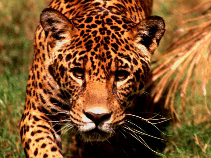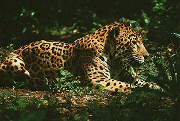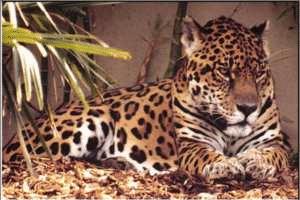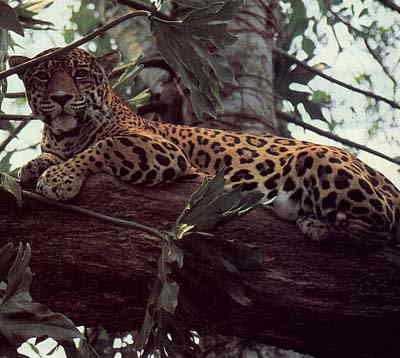Jaguars

Panthera onca



 The South American name "jaguara" means "carnivore that overcomes prey with a single bound."
The South American name "jaguara" means "carnivore that overcomes prey with a single bound." Jaguars are easy to recognize because of their spots. They have a rich, yellow to goldenrod coat, although they sometimes are black. Jaguars have rosette spots (a dark spot surrounded by a black circle). One Indian myth says that the jaguar acquired its beautiful spotted coat by dabbing mud on its body with its paws. These spots easily distinguish the jaguar from other big cats like lions and tigers.
Jaguars can be up to 9 feet long when you measure from their nose to their tales but they are normally about 5 feet long. They stand approximately 3 feet tall. Females typically weigh 80 pounds but can grow to as large as 140 pounds. Males typically weigh in around 120 pounds but have been found to weigh 250 pounds in Brazil. They live about 22 years in captivity.
 Often mistaken for the leopard, jaguars are larger than leopards. The coat pattern of the also two differs. The jaguars coat pattern has one or two small spots inside the larger rosettes, or circles, whereas the leopard does not.
Often mistaken for the leopard, jaguars are larger than leopards. The coat pattern of the also two differs. The jaguars coat pattern has one or two small spots inside the larger rosettes, or circles, whereas the leopard does not.
Jaguars rarely leave their forest dwellings because their gorgeous coat brings in a pretty penny for poachers. Many farmers also blame the death of their cattle and livestock on jaguars, although this is almost never the case. Due to the poaching and exile from farmers, the jaguar is rarely seen in the open.
 Jaguars are usually found around water in moist, heavily forested tropical areas. Some jaguars live in more arid habitats like the savannah and scrub. The jaguars range use to extend into the southwestern United States. But now the jaguar has become confined to southern Mexico, Central America and eastern Brazil. Native United States jaguars totally disappeared by 1950. There are still occasional sightings and reports of jaguars in the United States but these jaguars are of South American descent. The most abundant place to look for jaguars is in Brazil.
Jaguars are usually found around water in moist, heavily forested tropical areas. Some jaguars live in more arid habitats like the savannah and scrub. The jaguars range use to extend into the southwestern United States. But now the jaguar has become confined to southern Mexico, Central America and eastern Brazil. Native United States jaguars totally disappeared by 1950. There are still occasional sightings and reports of jaguars in the United States but these jaguars are of South American descent. The most abundant place to look for jaguars is in Brazil.
Jaguars are the only large cats that closely resemble United States cat species. Jaguars can climb trees and swim but they prefer to remain on the ground. Paleontologists have discovered jaguar remains that date as far back as the Ice Age.
 Jaguars have very large paws with a broad head and powerful jaws. They also have very powerful limbs that can carry themselves for hundreds of miles searching for prey.
Jaguars have very large paws with a broad head and powerful jaws. They also have very powerful limbs that can carry themselves for hundreds of miles searching for prey.
The jaguar does not roar like a lion. Instead, the jaguar growls, snarls and makes deep grunts.
 The diet of a jaguar may include wild pigs, fish, turtles, monkeys, deer, birds and even reptiles. Most large felines kill their prey a bite to the throat or neck. But jaguars often will bite through the temporal bones of the skull, right between the ears of the prey, crushing its skull. Jaguars are known to bury their prey and then return later to eat it. The jaguar hunts primarily at dusk and dawn by either stalking or ambushing their prey.
The diet of a jaguar may include wild pigs, fish, turtles, monkeys, deer, birds and even reptiles. Most large felines kill their prey a bite to the throat or neck. But jaguars often will bite through the temporal bones of the skull, right between the ears of the prey, crushing its skull. Jaguars are known to bury their prey and then return later to eat it. The jaguar hunts primarily at dusk and dawn by either stalking or ambushing their prey.
Jaguars live in caves and canyons close to a source of fresh water. The jaguar reaches sexual maturity when it is 3 years old. They will engage in mating normally in early autumn. It is in these caves and canyons that the female jaguar will give birth to her cubs. The gestation period is between 100-110 days. Between 1 and 3 cubs are born each weighing between 25 to 32 ounces. The cubs eyes will open after 13 days. After 6 months the cubs will learn to hunt. When they are about 2 years old, they will leave their mother to begin a solitary existence of their own.
Between the 1960s and 1970s, an estimated 18,000 jaguars were killed each day. Most were killed for their coat.

| NAME | LOCATION |
| Panthera onca arizonensis | Mexico |
| Panthera onca centralis | Central America |
| Panthera onca goldmani | Mexico, Belize |
| Panthera onca hernadesi | Mexico |
| Panthera onca onca | Amazon Rain Forest |
| Panthera onca palustris | Southern Brazil |
| Panthera onca paraguensis | Paraguay |
| Panthera onca peruviana | Peru, Ecuador |
| Panthera onca veraecrusis | Texas |
All are currently on the endangered species list. It is estimated that there are no more than 15,000 jaguars in the wild. We must prevent the illegal poaching, hunting of jaguars by angry farmers and their lose of habitat due to deforestation if these cats are to survive.
Save the Jaguar by the Wildlife Conservation Society
| MAKE SURE YOU SIGN MY GUESTBOOK! |
| AND THEN VIEW MY GUESTBOOK |
| COME AND SEE THE AWARDS I GOT |
| TAKE A TOUR THRU MY WEBRINGS |

| RUN WITH THE TIGERS | SEE THE SEA HORSES | DIVE WITH HAMMERHEADS |
| THE JAGUARS | SWIM WITH BLUE WHALES | EXPLORE THE AYE-AYE |
| DESCEND WITH EMPEROR PENGUINS | SPOT THE SPOTTED CUSCUS | FLY WITH THE BIRDS OF PARADISE |
| BULLY THE BULL SHARK | new animal soon!! | new animal soon!! |
 me!
me!